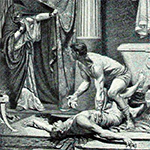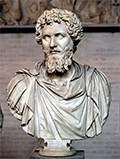The Year of the Five Emperors
The Year of the Five Emperors was a very chaotic year in the history of the Roman Empire, in which a series of strongmen attempted to hold on to the throne. Finally ending the chaos was Septimius Severus, who went on to sit on the throne for 15 years. 
On the last day of 192, the emperor Commodus found death at the hands of someone he trusted, his training coach and famous professional wrestler, Narcissus. Commodus had descended into madness during the latter part of his reign, had ordered a large number of executions, and had made a number of high-profile enemies. What he hadn't done was have a son or otherwise organize a successor. So his death, no matter how welcome it might have been to many people in Rome, left a void at the top. The first to fill that void was Pertinax, who at the time was serving as urban prefect. He had been a successful soldier, seeing action in Parthia and Britain and along the Danube; he had had political postings, including serving as consul for a time (along with Commodus), as procurator of Dacia, and as proconsul of North Africa. When Commodus was killed, members of the Praetorian Guard, which had sanctioned the murder, found Pertinax and declared him emperor. He agreed to take the throne and set about trying to undo some of the damage done by Commodus. He increased the value of the currency, hoping to prop up the crumbling treasury that Commodus had ransacked and then nearly bankrupted by devaluing the currency. He met with resistance to some of his plans for reforming the government. The one important thing that he didn't do was give a large sum of money to the Praetorian Guard, who had put him on the throne. After 86 days of waiting, several dozen of the Guard rushed the palace and killed Pertinax where he stood. Next on the throne was the person who paid the most money to the Praetorian Guard for the privilege. This was Didius Julianus (right), a In response, three powerful generals declared themselves free of their responsibilities to serve this new emperor and, further, declared themselves the rightful occupant of the throne. Pescennius Niger was governor of Syria. Clodius Albinus was commander in Britain. Septimius Severus was commander in Pannonia. Each of these generals had three legions, and each announced his intention to march on Rome and take the throne. 
Severus was closest to Rome, and so the emperor Didius Julianus declared Severus (right) an enemy of the state and sent an assassin to kill him. That attempt was unsuccessful, and Severus and troops made their way to the capital. Severus reached out to Clodius Albinus, seeking an alliance with him and offering to declare him Caesar; the two men found common ground. Severus and his legions reached Rome and overwhelmed the Praetorian Guard soldiers whom the emperor had ordered to defend the city. Sources differ on whether the Guard fought for the emperor or deserted him; either way, their defense didn't amount to much. Julianus offered to share the throne with Severus, but the latter refused. With Severus's impending arrival as what appeared to be a conquering hero, the Senate granted him the title of emperor. An abandoned Julianus was unprotected when a soldier came to kill him. He died on June 1, after ruling for 66 days. 
Severus was nominally the ruler of Rome at this point, but Niger (left) was still in the field, with three legions at his back, proclaiming him as the rightful emperor. The two armies clashed in series of battles and then, at Issus in 194, Severus was finally victorious. His troops pursued a fleeing Niger and dispatched him. They later seized Byzantium as well. 
Severus, mindful of the chaos that had ensued with the lack of a stated heir, named his son Caracalla as his successor. This triggered a response from Albinus (right), who renewed his claim to the throne. Albinus had been a consul in 194 and had been the effective ruler of the western half of the Empire. However, Severus, in naming his son heir, stated his intention to embark on sole rule, going so far as to convince the Senate to declare Albinus an enemy of the state. Severus and Albinus fought each other on Feb. 17, 197, at Lugdunum, with forces that approached 150,000 on each side, and Severus was victorious. Albinus was killed during or after the battle. (Sources differ.) Severus, who had been one of five men to have claimed the title of Emperor in 193, was now the sole ruler of the Empire. |
|
Social Studies for Kids
copyright 2002–2025
David White



 wealthy Senator. He, too, had a lengthy record of service, including serving as consul along with Pertinax in 175. He fought in Germany and later served as proconsul of North Africa. His "purchase" of the throne was widely known, and he was sometimes greeted with jibes by a public that wanted nothing so much as honor and stability from their emperor, something that they had as recently as 180, in the reign of
wealthy Senator. He, too, had a lengthy record of service, including serving as consul along with Pertinax in 175. He fought in Germany and later served as proconsul of North Africa. His "purchase" of the throne was widely known, and he was sometimes greeted with jibes by a public that wanted nothing so much as honor and stability from their emperor, something that they had as recently as 180, in the reign of 
